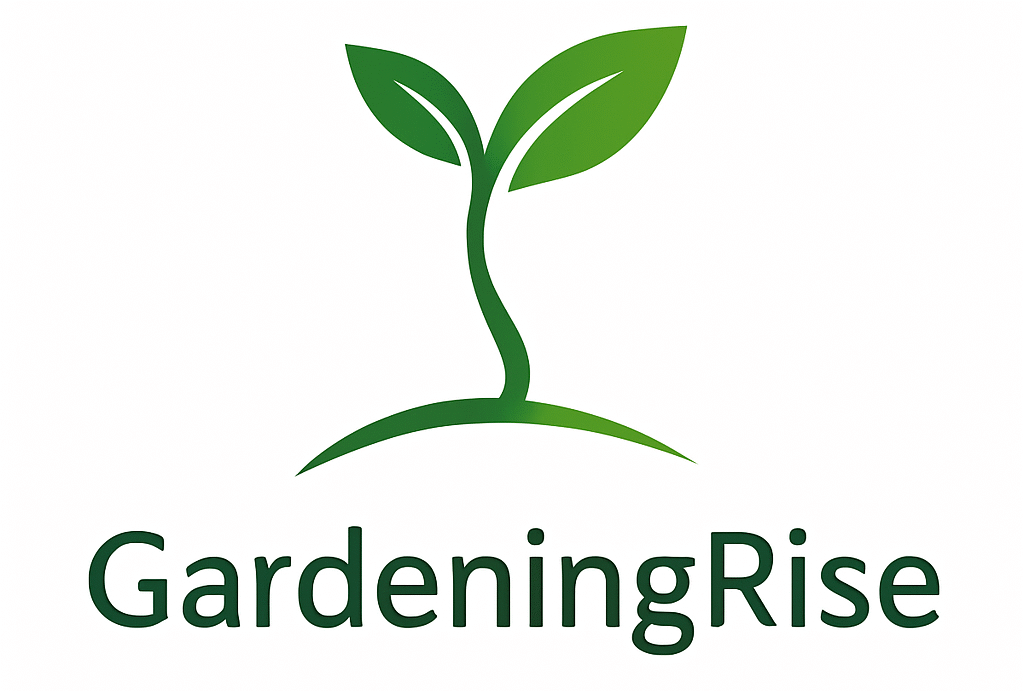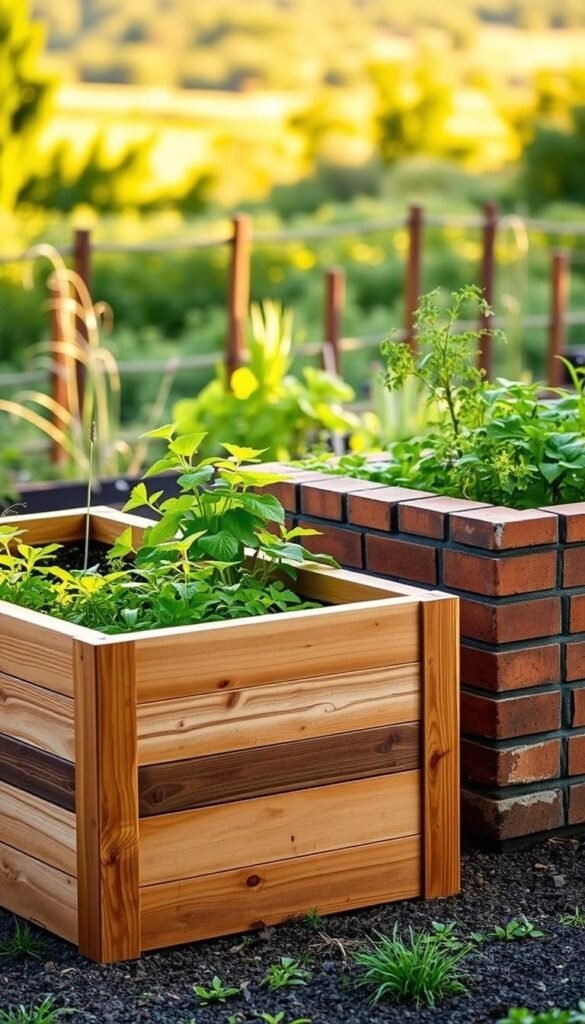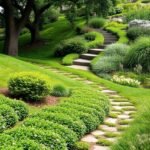Choosing the right foundation for your plants can transform your outdoor space. Whether you’re growing herbs on a patio or vegetables in a backyard, elevated planting systems offer unique advantages. Let’s explore how two distinct approaches—modular designs and permanent structures—can elevate your gardening experience.
Flexible setups allow quick adjustments as your needs change. These lightweight options work well for renters or those experimenting with layouts. On the other hand, sturdy constructions provide lasting elegance, blending seamlessly with your home’s aesthetic. The choice depends on factors like budget, available space, and how long you plan to maintain your green oasis.
Durability varies widely between materials. Some last decades, while others need replacement every few years. Cost-effective solutions exist too—creative builders can craft functional designs for under $22 using reclaimed wood or affordable supplies, as shown in this budget-friendly guide.
We’ll break down installation complexity, seasonal upkeep, and real-world performance data. By the end, you’ll know exactly which approach aligns with your vision—whether you prioritize quick setup, timeless beauty, or low-maintenance practicality.
Understanding Raised Garden Beds in Today’s Garden Space

Modern gardening innovations have reshaped how we cultivate plants in limited spaces. Elevated planting systems let you grow herbs, vegetables, or flowers without straining your back. Their raised design positions soil at waist height, making planting and weeding far more comfortable.
These beds warm soil faster in spring than traditional gardens. You’ll gain 2-3 extra weeks for sowing seeds, helping heat-loving crops thrive. The contained structure also discourages burrowing pests like moles while keeping deer from nibbling your tomatoes.
One standout advantage? Your soil stays loose and nutrient-rich. Unlike compacted ground soil, raised bed mixtures remain aerated for stronger root growth. Customize your blend with compost or sand to match your plants’ needs—whether you’re growing carrots or chrysanthemums.
Want to start small? Many gardeners build their first raised bed garden in a weekend using basic tools. The controlled environment simplifies weed management too—you’ll spot invaders quickly before they spread.
Over time, these systems become richer ecosystems. Each season’s amendments create soil that supports bigger harvests. Whether you’re growing salad greens or sunflowers, raised beds adapt to your garden’s evolving story while saving your knees from constant bending.
Overview of Box Style Raised Garden Beds

Your garden’s layout can evolve effortlessly with modular solutions. Box-style systems use straight-edged designs made from wood planks, powder-coated metal, or weather-resistant composites. These materials create sharp angles that define planting zones while resisting rot and pests.
Assembly takes minutes with pre-cut kits. Most products include numbered parts and visual guides—no advanced skills needed. One gardener shared:
“I built my first bed during lunch break. By dinner, I was planting tomatoes!”
Customize your setup with these options:
| Material | Assembly Time | Lifespan | Cost Range |
|---|---|---|---|
| Cedar Wood | 20-40 mins | 7-12 years | $60-$120 |
| Galvanized Steel | 10-25 mins | 15+ years | $90-$180 |
| Recycled Plastic | 5-15 mins | 10-15 years | $45-$95 |
Expand your growing space by connecting units like puzzle pieces. Stack taller frames for deep-rooted crops or arrange L-shapes around patios. Unlike permanent stock tank setups, these systems let you redesign each season.
Replace single panels if damaged—no need to rebuild entire structures. Choose heights from 12″ for herbs to 36″ for wheelchair access. Your back will thank you during harvest time!
Overview of Brick Style Raised Garden Beds
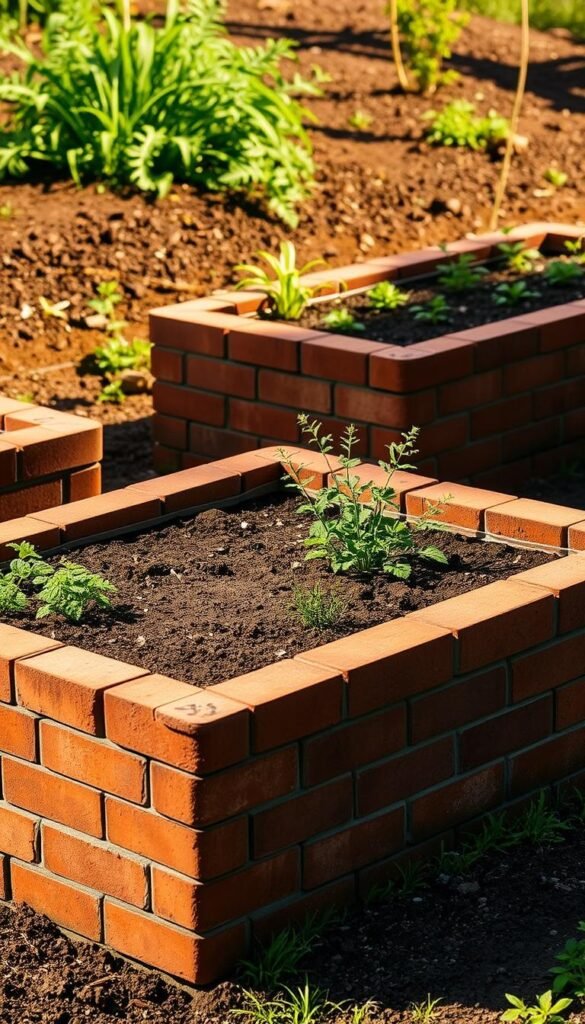
Transform your outdoor space into a year-round sanctuary with masonry-based planting systems. Built from clay, concrete, or reclaimed bricks, these permanent structures blend strength with artistry. Their thermal mass acts like a natural thermostat, keeping soil warmer in spring and cooler during summer heatwaves.
One gardener noted:
“My peppers ripen two weeks earlier since switching to brick—and the basil thrives until frost!”
The curved walls and geometric patterns create microclimates perfect for heat-loving tomatoes or shade-preferring lettuces.
These landscape anchors evolve with your property. Train climbing roses along their textured surfaces or add built-in benches between tiers. Unlike temporary setups, brick designs mature gracefully, developing a weathered charm that complements your home’s exterior.
Key advantages include:
- 50+ year lifespan with minimal upkeep
- Custom heights from 18″ to 36″ for ergonomic access
- Seamless integration with stone pathways or patio edges
Mix brick colors and laying styles—herringbone for cottage charm or stacked bonds for modern flair. Your garden beds become living sculptures that nourish both plants and curb appeal.
Box vs. Brick: Comparing Popular Styles of Raised Garden Beds
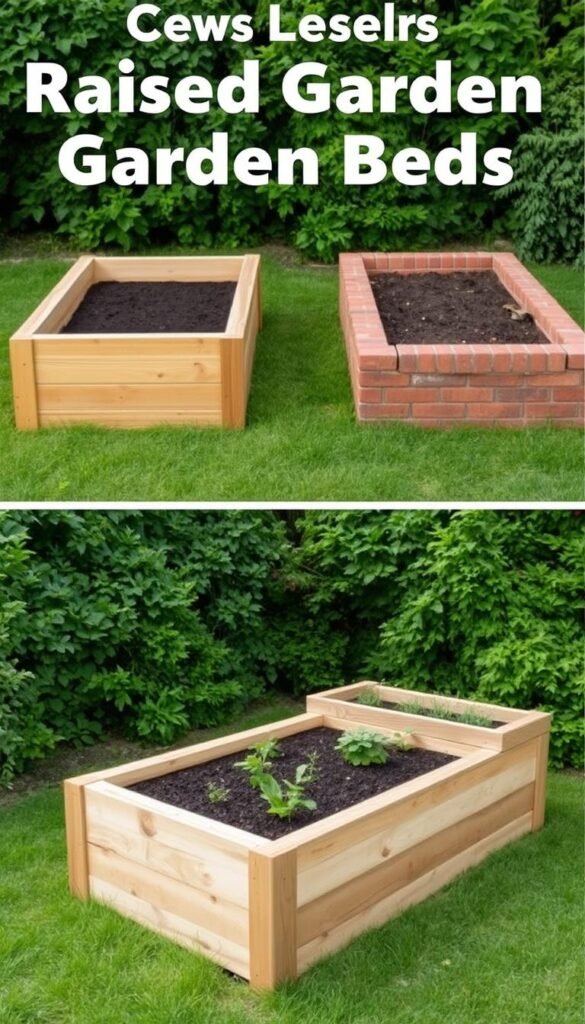
Selecting the perfect growing system shapes how you interact with your landscape. Modular designs let you rearrange planting zones like furniture, while masonry structures become enduring parts of your yard’s architecture. The choice impacts everything from weekend projects to decades of harvests.
Speed versus permanence defines this decision. Prefab units snap together in under an hour—you could plant radishes before sunset. Permanent installations demand careful leveling and mortar work, often requiring multiple weekends. One urban grower shared:
“My brick beds took three Saturdays to build, but now they’re the pride of my backyard!”
| Feature | Modular Systems | Masonry Designs |
|---|---|---|
| Setup Time | 1-4 hours | 3-14 days |
| Cost Range | $40-$200 per bed | $300-$900+ |
| Lifespan | 5-15 years | 30+ years |
| Best For | Renters & experimenters | Long-term gardeners |
Your budget plays a key role too. While modular options cost less upfront, replacing warped boards adds up. Brick requires significant initial investment but becomes a landscape asset that boosts property value.
Aesthetic preferences matter as much as practicality. Sleek metal frames complement modern patios, while weathered brick harmonizes with cottage-style gardens. Consider how each style interacts with your existing garden beds and outdoor living areas.
Ultimately, your decision rests on three factors: how quickly you want results, your willingness to maintain structures, and your vision for the space. Both approaches yield bountiful harvests—they simply grow from different gardening philosophies.
Design, Materials, and Aesthetic Appeal
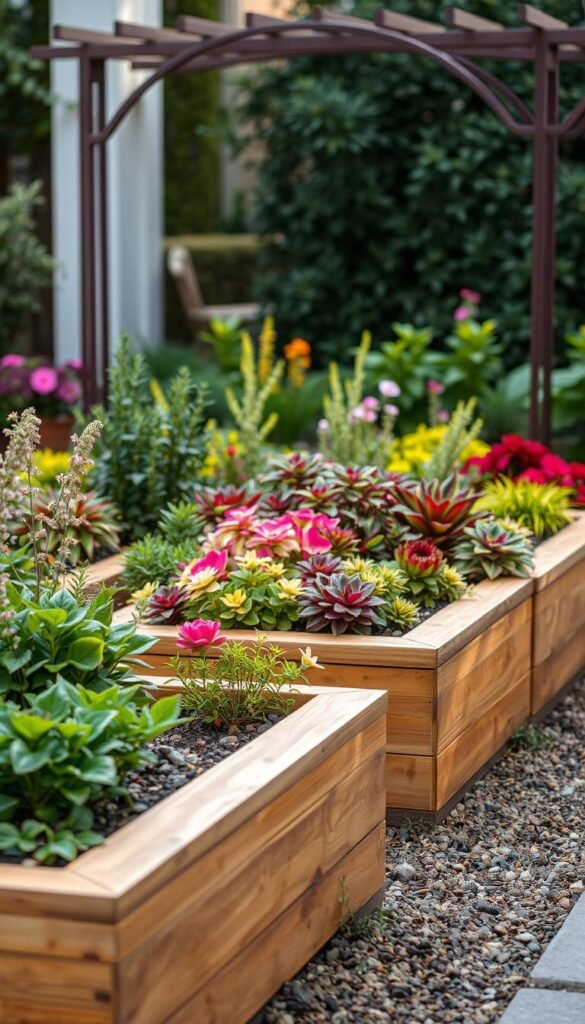
Your garden’s visual harmony begins with thoughtful material choices. Whether crafting a cozy cottage vibe or sleek modern lines, your raised bed materials become the stage for your plants’ performance.
Wood vs. Metal: Decoding Options
Cedar planks bring earthy warmth to traditional homes, aging to a silvery-gray that complements rustic landscapes. For contemporary spaces, powder-coated steel frames create crisp geometric shapes. One gardener shared:
“The charcoal metal beds made my mid-century patio look like a design magazine spread!”
Consider these comparisons:
| Material | Style Match | Key Benefit |
|---|---|---|
| Cedar Wood | Farmhouse/Cottage | Natural pest resistance |
| Galvanized Steel | Modern/Industrial | 20+ year lifespan |
| Recycled Plastic | Eclectic | Rainbow color options |
Aesthetic Integration with Your Home Design
Match your home‘s architectural language. Mediterranean villas pair beautifully with terra-cotta planters, while Craftsman bungalows shine with stained cedar boxes. For patio container gardening, choose slender metal troughs that mirror balcony railings.
Dark bronze finishes disappear into lush greenery, letting blooms take center stage. Warm wood tones echo decking materials for seamless transitions. Your garden beds should whisper “this belongs here” rather than shouting for attention.
Functional Benefits for Your Gardening Experience
Elevated gardening solutions do more than save space—they transform how you interact with your plants. By bringing soil to comfortable heights, these systems let you nurture your garden without straining your body. Let’s explore how smart design choices can boost both your harvests and well-being.
Ergonomic and Health Benefits
At 24-30 inches tall, raised beds position your soil at waist level. You’ll spend less time hunched over—perfect for tending herbs or checking tomato progress. One gardener shared:
“After switching to 29-inch beds, I can weed for hours without back pain!”
The height advantage helps those with arthritis or limited mobility. No more kneeling on hard ground or struggling to stand up mid-task.
Extended Growing Season Advantages
Your gardening calendar gains flexibility with elevated setups. Soil warms faster in spring, letting you plant heat-loving crops 2-3 weeks earlier. Improved drainage prevents root rot during rainy spells while retaining moisture in summer.
| Plant Type | Ideal Soil Depth | Season Extension |
|---|---|---|
| Leafy Greens | 6-8 inches | 3 weeks earlier |
| Tomatoes/Peppers | 12-18 inches | 4 weeks longer |
| Root Vegetables | 18+ inches | 2 weeks earlier |
Customize depths when designing your square-foot gardening layout. Shallow beds work for basil and lettuce, while deeper setups support carrots and potatoes. Your garden becomes a year-round producer!
Ease of Assembly and Installation Tips
Setting up your growing space shouldn’t feel like solving a puzzle. Modern designs prioritize straightforward assembly, letting you focus on planting rather than construction headaches. Whether you’re a weekend warrior or a busy parent, smart engineering makes the process accessible to everyone.
Tool-Free Assembly Insights
Snap-together systems eliminate the need for drills or saws. One gardener reported:
“We clicked the panels into place while drinking coffee—no tools required!”
But keep in mind: advertised 30-minute setups might take longer your first time. Clear instructions with diagrams help avoid confusion during building raised beds.
| Bed Type | Average Assembly Time | Tools Needed |
|---|---|---|
| Basic Modular Kit | 20-40 mins | None |
| Multi-Tier System | 1-2 hours | Rubber mallet |
| Custom Shapes | 2-3 hours | Level |
Make sure your ground is level before starting—uneven surfaces cause alignment issues. Pre-drilled holes guide connections, but test-fit pieces first. Modular designs let you disassemble beds if you relocate or redesign your garden layout.
Seasoned builders recommend these steps:
- Lay out all components before starting
- Follow numbered assembly sequences
- Tighten connections gradually
With practice, you’ll master easy assemble techniques that save time season after season. Your future self will thank you during spring planting rush!
Durability and Long-Term Performance
Your garden’s backbone lies in the materials you choose. Cedar and steel stand out for their ability to weather seasons while keeping your plants thriving. Cedar naturally resists rot and pests, often lasting 7-12 years without chemical treatments. Its warm tones soften over time, blending into lush greenery.
Galvanized steel beds offer unmatched longevity—many survive 20+ years with minimal care. Their powder-coated surfaces shrug off rust, even in rainy climates. One gardener shared:
“My steel beds look new after five winters, while wooden ones needed replacing!”
Proper soil preparation boosts your bed’s lifespan. Balanced pH levels and drainage prevent corrosion and wood decay. Mix in compost annually to maintain structure without stressing the walls.
Consider your timeline. Renters love lightweight metal for easy moves, while homeowners invest in cedar’s rustic charm. Both options outlast plastic by decades, proving that smart material choices yield gardens that grow better with age.
